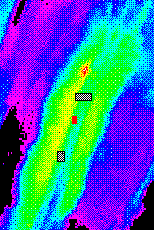
![[Map of Dive Track]](track_2929.gif)
Port Observer: Delaney
Starboard Observer: Veirs
Pilot: Hickey
Date: 6/2/95
Summary
Dive Objectives: Extend geological map of the High Rise Vent Field, obtain water samples and vent fluid temperature measurements at Ventnor, Knight and/or Blue Moon, Fairy Castle, Baltic, and Park Place, mark structures and sample sites, retrieve biological and water samples from diffuse vent area, survey structures (especially Boardwalk) for a flange to be collected on a later dive, sample the buoyant plume above Godzilla, and "ground truth"; high-resolution bathymetric and side scan sonar maps.
Summary: Sighting the seafloor at 9:13 am, we navigated to Ventnor (large marker 1M) within 10 minutes, circumnavigated the active structure following the sulfide/basalt contact, and sampled a black smoker (small marker AI) [major/gas tight/T=340°C].
After leaving Ventnor at 10:00, we crossed lobate basalt flows and tube worm beds to reach Knight, a sulfide structure with spires but no vigorous venting. We elected not to sample and by 10:07 were approaching Fairy Castle above rounded basalts 3 m in diameter and clumps of tube worms. After sampling a black smoker (small marker AR) [major/gas tight/T=331°C] at the top of Fairy Castle, we circled the base and discovered tube worm beds on basalts paralleling the basalt/sediment contact, as well as a tall (2 m) chimney based in the sediments, venting diffusely. We left a marker (large 1V) atop an inactive flange at Fairy Castle's base and departed at 10:54.
We passed extensive, sedimented lobate flows and tube worm beds en route to Baltic, then ascended the steep sulfide structure at 11:09 to sample its sole black smoker (small marker AQ left about 3 meters to west) [major/gas tight/T=326.5°C]. Beneath Baltic's towering, fluted spire we chose a mid-level, inactive flange on the south face on which to place a large marker (1U). Traversing to the east of the edifice at 11:48, we passed huge
tube worm beds and "budding"; sulfide spires (1.5 m) capping a north-south ridge "frosted"; in white bacteria.
We reached Park Place at 11:50 and sampled water at a black smoker (small marker AO) [major/gas tight/T=330°C] near the top of the structure above and to the east of a tall "beehive"; on the upper west face. Before departing to the north at 12:23, we placed a large marker (1X) safely on a terrace of inactive flanges half way down the south face.
Boardwalk boasted abundant, active flanges; we found the small A8 marker left aside the diffuse flow of a flange two days previously and video-surveyed a nearby, potentially-collectable flange. We left a small marker (AL) there. Moving northward again at 12:52 we glimpsed Three Sisters (defunct mound, broken sulfide blocks, and some diffuse venting) before proceeding to a significant fault (about 5 m offset with strike northeast-southwest). Long (1.5 m), thin (0.5 cm diameter) tube worms thrived along the base of the fault where sediments contacted fractured pillow basalts. We collected a sample in the bio-box after probing their beds in search of diffuse flow [Tmax=14°C]. The site was marked with a large marker (1P) before departing to the south at 13:30.
We left the seafloor at 1:34 conducting a vertical scan of Godzilla and then rising (attempting neutral buoyancy and zero propulsion) in its buoyant plume. We were advected within the plume to the south at approximately 0.1 m/s and triggered 3 Niskin bottles at 5, 20, and 52 m above Godzilla's peak.